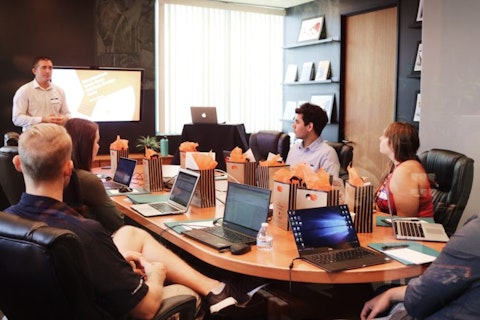Orchard Therapeutics plc (NASDAQ:ORTX) Q4 2022 Earnings Call Transcript March 10, 2023
Bobby Gaspar : Hello, everyone. I’m Bobby Gaspar, CEO and Co-Founder of Orchard. I’m especially delighted to host our fourth quarter 2022 conference call, where we have a number of important corporate and regulatory updates, along with providing our full financial results. Before we get started, I want to remind everyone that this presentation contains forward-looking statements. Please refer to this slide and our latest SEC filings for more information. I believe in news we announced this morning and that we will discuss during this call constitute a breakthrough moment in the evolution of our company and our HSC gene therapy platform. I have three members of the leadership team joining me on today’s call. Following my remarks, Frank Thomas, President and Chief Operating Officer, will provide more view on the financing we announced this morning, along with a summary of our financial results for the quarter; Braden Parker, our Chief Commercial Officer; and Leslie Meltzer, our Chief Medical Officer, will also be joining for Q&A.
Our plan is to keep our prepared remarks focused on 3 primary topics during this call. First, to provide you an update on Libmeldy commercialization in Europe. Second, we will cover recent significant developments in the U.S. with our interactions with the FDA. And third, to review the financing that we announced this morning that will take the need for additional capital off the table for the foreseeable future. Let’s start with Libmeldy. We’ve always believed HSC gene therapy will be the future for treating certain severe neurometabolic disorders. And with the approval and launch of Libmeldy in Europe, we are making that future a reality for patients with MLD. Our commercial and medical teams continue to identify, refer and support treatment of eligible MLD patients and we are seeing signs that disease awareness is growing among the physicians diagnosing and managing patients.
In fact, we expect will be reflected in our annual revenue figures for 2023. Libmeldy generated just under $20 million in sales in 2022 during its first year of launch, and that was only with a few reimbursement agreements in place. As we expand access and reimbursement to other markets in Europe and see the implementation of additional newborn screening studies, we are optimistic that sales will continue to grow in 2023 in Europe, while we also prepare for a potential 2024 launch in the U.S. We’ve spoken frequently about the importance of newborn screening. And to date, 3 confirmed cases of MLD have been identified after the screening of 96,000 newborns globally. One of these cases has been assessed clinically and referred for treatment with Libmeldy, while the other 2 more recently identified patients are pending clinical assessment.
You may recall that previously we have talked about the incidence of MLD being 1 in 100,000 live births. While these data are still early, it does suggest that the incidence and consequently the commercial opportunity may be higher than previously published. In total, 6 studies are actively screening newborns in Europe, the Middle East and the U.S. with additional pilots starting this year. Turning to the U.S. As planned in early 2023, we held a constructive Type B clinical meeting with the FDA on our potential BLA submission for OTL-200 for MLD. This meeting provided clarity on key elements of the clinical package that have been pointed to ongoing dialogue with the FDA, including our natural history comparator data and the predictability of the clinical course in presymptomatic patients.
Based on the outcome of this meeting, we requested a pre-BLA meeting, which we are very pleased to confirm, has been granted by the FDA and is now scheduled for the second quarter of 2023. We are also in the process of addressing remaining questions on our CMC comparability package. Assuming a successful outcome following the multidisciplinary pre-BLA meeting, we now anticipate a potential mid-2023 BLA submission for OTL-200. We are very pleased to have come to this point and look forward to our continued partnership with the FDA as we work to bring this important therapy to patients in the U.S. We believe we are likely to be granted a priority review. And with a potential submission in the middle of this year, we can expect an approval and launch in the first half of 2024.
So we believe during the past couple of months, we have come a long way and are now on the cusp of some key inflection points for OTL-200. This progress led to the other part of today’s news, which is the strategic financing that Frank will talk about in a minute. Before I turn it over to Frank, I want to also mention that the rest of our portfolio continues to make progress as well, including our programs in MPS I Hurler syndrome, where we are preparing to initiate a registrational study, MPS IIIA Sanfilippo syndrome and the NOD2 genetic form of Crohn’s disease. We’ll be in a position to talk about these programs in future press releases and conference calls. So okay, with that, let me turn the call over to Frank.

Photo by Campaign Creators on Unsplash
Frank Thomas : Thanks a lot, Bobby. I believe 2023 is setting up to be a pivotal year for Orchard as we strive to fully unlock the curative potential of our HSC gene therapy platform. We’re now a commercial stage company with significant revenue potential with Libmeldy and an infrastructure in manufacturing, distribution and commercialization that can be leveraged for our other clinical and preclinical programs. Libmeldy will drive near-term growth. And as the pipeline matures, our therapies will utilize many of the same organizational capabilities that we’re developing today. The first 2 months have proven to be quite positive for the company, and I know our employees are focused on delivering results for the rest of the year also.
We have had an IND cleared for OTL-203, clinical data presented at the WORLD Conference for OTL-201, the regulatory progress that Bobby described with the FDA and patient identification ramping up through newborn screening. All that progress attracted the interest of a group of leading health care investors, and we were able to structure a very significant financing for the company. Not only does the financing provide near-term capital to accelerate our commercialization, but it also provides for future closings that could negate the need for additional financing and allow the company to focus and execute on our business plan and growth strategy. The total proceeds could be up to $188 million and will be used to fund Libmeldy in Europe, while simultaneously preparing for a potential U.S. approval and launch as well as advance our portfolio of next-in-line MPS programs and research in larger indications.
RA Capital led the transaction and worked closely with us to structure the financing to support a long-term vision for our company and to build a sustainable business. The financing is comprised of 3 elements: A $34 million upfront investment that is priced at a 25% premium to Friday’s closing price. These proceeds alone will extend our runway into 2025. There is a second anticipated closing of $34 million based on a successful pre-BLA meeting and shareholder approval of additional authorized shares, both of which are expected to occur in the second quarter of 2023. The final element is a warrant structure that would provide up to $120 million upon FDA approval of OTL-200 for MLD in the U.S. in 2024. This assumes all warrants are exercised at $1.10 per share.
We believe the deal structure is good for our existing shareholders with each potential closing priced at progressively higher valuations and share prices. It’s also attractive to participating investors with their incremental committed capital as OTL-200 advances towards potential regulatory approval in the U.S. We want to thank each of the participating investors for supporting this unique and innovative structure and partnering with us to build a special company in the field of gene therapy. Now turning to our financial performance, starting with revenue from Libmeldy, which was $5.8 million for the fourth quarter and $18.8 million for the full year. Total revenue in the fourth quarter, which includes Libmeldy plus collaboration revenue and sales of Strimvelis was $7 million compared to $0.5 million in the same period in 2021.
Cost of goods sold was $2.4 million, which primarily comprises manufacturing costs, royalties to third-parties and noncash amortization. This resulted in gross margins from product sales of approximately 65% to 70% for the quarter and year-to-date periods. Beyond Libmeldy revenue and costs, you can find the full financial results from the fourth quarter in this morning’s press release. It’s worth calling out that the restructuring that we completed in March 2022 has been pulled through the quarterly results with a 38% overall reduction in our burn rate when comparing the fourth quarter against the first quarter of 2022. We ended the year with cash and investments of approximately $144 million. During the fourth quarter, the company used about $23.5 million in cash to fund operations, excluding offsets from onetime items.
Our focus and financial goals for 2023 are continuing to grow Libmeldy sales over 2022 and managing our operating expenses, which should lead to a continued downward trend in our annual burn rate. Looking forward to upcoming milestones, I believe Orchard is well positioned to become the breakout leader in gene therapy as we continue to gain traction on the Libmeldy launch in Europe and demonstrate a sustainable business model for onetime potentially curative therapies. In addition to our commercial objectives, we also will prepare for a potential U.S. approval and launch and advance a pipeline of clinical and research candidates in various stages of development. So with that, I’ll turn the call over to the operator for your questions.
See also 12 Most Profitable Biotech Stocks Today and 15 Companies that Just Started Paying Dividends.
Q&A Session
Follow Orchard Therapeutics Plc (NASDAQ:ORTX)
Follow Orchard Therapeutics Plc (NASDAQ:ORTX)
Operator: And your first question comes from the line of Dae Gon Ha from Stifel.
Dae Gon Ha : Congrats on all the progress. Maybe two from me. One on the Type B meeting/pre-BLA. So Bobby, I guess, can you maybe provide any more color around this comparability with the natural history cohort and the predictability aspect? I know that’s been kind of the sticking point that you wanted to discuss in the Type B meeting. Has that been fully resolved, leading you to have a more optimistic outlook heading into the pre-BLA? Or is there still more discussions to be had and kind of latching on to that, the CMC aspect, what additional aspects need to be ironed out before the pre-BLA meeting? And then second question for Frank. With regards to OTL-200, the 34, 34 and then 120 tranches you just laid out, the first 34 was already enough to get you into 2025. Just wanted to ask, can you remind me on the OTL-200 program, is that eligible for PRV? And does the cash runway already include that 2025, sorry, does that already include the PRV monetization?
Bobby Gaspar : Thank you, Dae Gon. So maybe I’ll take the first bit, and Leslie may be able to comment as well. But just to kind of address that question, which I think is all about the overall path to this pre-BLA meeting. I’ll just step back for a second because, remember, about 6 months ago, we talked to the FDA, and FDA said that we weren’t ready for a pre-BLA meeting. And they wanted to discuss some clinical questions as you outlined in the context of the Type B clinical meeting. And they also said they would review our CMC comparability package. And so with regards to the clinical aspects, we had a constructive Type B clinical meeting with them, where we addressed those specific points that you talked about, which is the natural history comparator arm and the validity and the robustness of that and also the predictability of the clinical course in presymptomatic patients.
And again, I think we resolved these issues, and that was part of the reason that the FDA said that we could now advance to a pre-BLA meeting. On the CMC side, where we’ve had a number of dialogues with the FDA on the CMC side as we did for the clinical side. We’re narrowing down on some specific questions as far as the comparability is concerned, we’re in interaction with the FDA as far as that is concerned, it’s also something that we can talk to them about at the pre-BLA meeting and also during the BLA submission as well. So that is ongoing. But I think the main thing is, obviously, having said that, we weren’t ready the FDA now saying that we are ready for a pre-BLA meeting, request the meeting. The meeting has been granted and is in the diary for Q2.
Frank Thomas : So maybe then with respect to the financing burn and PRV question. I mean, when I think about the burn just generally over a multiyear period, I would expect that we’ll continue to see growth in Libmeldy over the next several years, especially as we look to bring on the U.S. market and eventually other markets globally. So you’ll have a contribution coming from that revenue that will offset the burn. I think on the OpEx line, I would expect flat to slightly down operating expenses as we complete the submission of the BLA, I think we’ll start to see R&D expenses come down a bit. So overall, I feel like the first tranche of the financing gets us into ’25. The second tranche of the financing gets us, I would say, well into ’25.
And then if the proceeds come in from the third piece, the warrants are exercised, then I think we have the opportunity with all of that capital to substantially extend our runway through to Libmeldy certainly being profitable and beyond. So I think this is a very important financing for the company when you combine the proceeds plus the existing cash. With respect to the PRV, unfortunately, we do not have rights to the PRV. If you recall, we licensed in MLD from GSK back in 2018 for very little money upfront, but the downstream consideration was that they would get royalties on sales and that they would get the PRV from this program. So essentially, if we get or when we get the PRV, it will be transferred to GSK. So I’ve not included any proceeds from PRV monetization in my runway assumptions.
Operator: And your next question comes from the line of Hartaj Singh from Oppenheimer & Co.
Hartaj Singh : Just a couple of quick questions, a little bit disparate. One is just on the three patients. You’ve been able to find over 96,000 patients. I know that seems to be quite higher than the one in the 100,000 that seems to be sort of the academic work that’s been done, Bobby. Just any thoughts there, and do you see that as sort of the trend going forward? It’s quite a difference from what we’ve seen out in the academic study. And then secondly, just on the integrated data analysis you presented both on the safety side, you — type B meeting with the FDA, how much in-depth discussions were there looking at that specific integrated analysis and especially on safety and some of the insertional mutagenesis issues or if there were any? Just what were the discussions around that?
Bobby Gaspar : Thank you, Hartaj. So let me talk about the newborn screening piece first of all. So I think, importantly, the figures that we previously had quoted come from a retrospective analysis, numerous different retrospective analyses talking about the incidence of MLD. And those ranged anything from, I think, an instance of 1 in 30,000 to up to 1 in 250,000. And the average was around 1 in 100,000. Remember, there’s always an ascertainment bias in those retrospective analysis. It’s — patients will have been missed. And so usually, especially in these rare diseases, where the incidence is higher than previously published because now you start to capture every child. And so you could only do that with prospective analysis through newborn screening.
And so that’s what we started to do. And so it’s been the first year of screening, nice 6,000 babies screened and 3 genetically confirmed cases of MLD. I will also add that there was a prospect deidentified study that was conducted in Washington State. And there 27,000 babies were screened and 1 MLD baby was identified. So that’s a separate study to what we’ve seen. And again, these are prospective screens. So on the basis of that, all I can say is it’s probably not enough baby screens to give a true epidemiology. But as I said in my prepared remarks, it does suggest that the incidence may be higher than what was previously published and predicted. And I think we will just need to screen more babies to get a full true incidence picture. But let’s say it does point to something that might be slightly higher than 100%.
It’s just exactly how much higher, I think fits difficult to say at this time point. So we’ll keep doing that, and we are anticipating doing even more than 100,000 screens this coming year with all the pilots that are actually planned. So we’ll get nearer to understanding exactly what that true incidence figure is. On the second point with respect to the integrated analysis and I’ll let Leslie kind of comment on the overall facts. But I will comment that there wasn’t really anything about the insertional mutagenesis picture because we’ve never had a case of insertional mutagenesis. We never even had a molecular signal of clonal expansion or insertional mutagenesis within that program. And the reason for that, and I’ve talked about this previously, is about the promoters that we have used in our lentiviral vectors.
So remember, the events that were seen of insertional mutagenesis using lentiviral vectors are related to the use of viral, internal viral promoters which have enhanced the sequences that can activate genes. And in all our programs, we have used human promoter and regulatory elements that do not have the capacity to activate neighboring genes. And we believe that is the reason why we have such a strong safety profile as far as that is concerned. Let me hand it over to Leslie to talk about other aspects…


